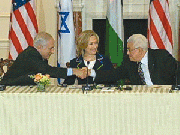The ‘Palestine Papers’ followed by Wikileaks data suggest that the PA has been engaged in extensive cooperation with the Israelis.
RAMALLAH (IPS) – The credibility of the Palestinian Authority (PA) on the Arab street has been further weakened by the release of the ‘Palestine Papers’, but ironically the release of the explosive documents by Al Jazeera could bolster support for the Palestinian cause internationally.

|
| New leaks confirm Israeli intransigence in face of weak, desperate Palestinian Authority |
The release of these papers has now been followed by data through Wikileaks that suggest that the PA has been engaged in extensive cooperation with the Israelis.
But while the release of documents that point to a strong Palestinian push to make compromises in negotiations could garner global support for the theoretical establishment of a Palestinian state, it appears that practical facts on the ground by way of settlement building have rendered a two-state solution to the protracted Palestinian-Israeli conflict null and void.
The only viable option, many analysts agree, is ultimately an egalitarian, non- racist one-state solution for Palestinians and Israelis living together.
“Despite the crowing of the PA’s critics in light of the enormous damage and embarrassment the documents’ release has caused the PA, stronger international support could be another outcome,” Dr Samir Awad from Birzeit University near Ramallah told IPS.
“As international sympathy for the Palestinian cause continues to grow, against a background of Israel’s most right-wing, and some argue, most racist government to date, Israeli intransigence in the negotiations, and its repeated claims that it has no peace partner in the Palestinians, have been fully exposed as bald-faced lies.”
Israeli analyst Aluff Benn concurred when he commented in the Israeli daily ‘Haaretz’, “The documents show that contrary to the ‘no-partner’ image perpetuated by Israelis, the Palestinians were holding serious negotiations on the borders of their future state and produced a detailed map of territorial exchanges in the West Bank and neighborhood partitions in East Jerusalem.”
“It is entirely possible that the dramatic leak may have a boomerang effect that will see increased support for Palestinian President Mahmoud Abbas, who is being portrayed as wrongfully persecuted,” said Israeli commentator Avi Issacharoff.
“Despite initial fears, it’s likely that the release of the Palestine papers by Al Jazeera and The Guardian will not bring about a political earthquake in the Palestinian Authority – or even a power struggle within Fatah,” added Issacharoff.
These fears, and more, were voiced by PA officials who responded with fury in the media, slamming Al Jazeera in long monologues and accusing the Qatar- based station of having an agenda regarding the timing of the documents’ release.
A group of young men – believed to be Fatah activists and possibly PA security force members – tried to break into Al Jazeera’s Ramallah office, causing some damage before Palestinian police intervened. This is a tactic Fatah supporters have used before to attempt to create the impression that they were regular citizens angered by the PA’s critics.
However, despite experts across the divide agreeing that, although weakened, the PA will ultimately survive the explosive disclosures, Israel’s deliberate strategy of settlement building in the occupied West Bank seriously threatens the practicality of a Palestinian state.
“There was a brief window of opportunity for the successful implementation of a two-state solution several years ago. But Israel’s continued settlement building in and around East Jerusalem and in the West Bank have made the possibility of the establishment of a contiguous Palestinian state impossible,” says Awad.
Facts on the ground have changed dramatically since the Palestinian negotiators presented the “most generous offer ever” in regard to the borders of their future state.
Currently the West Bank is divided into three cantons and represents a Bantustan with bits and pieces of Palestinian areas surrounded by illegal Israeli settlements, while parts of East Jerusalem are isolated from the rest of the city by settlements.
The maps presented by the Palestinian negotiators, which were based on the Clinton peace plan and the Geneva Initiative, are no longer a geographic reality.
The Geneva Initiative map for example left one large illegal Israeli settlement of Har Homa in East Jerusalem in Israeli territory but the Palestinian maps marked the settlement on the Palestinian side of the border. Due to continued settlement construction Har Homa has grown and in future the Israelis want it included inside the borders of the Jewish state.
Another illegal settlement bloc Etzion, which is adjacent to Jerusalem, has also grown substantially and eats further away into Palestinian territory. This, analysts argue, was always the Israeli plan – to build extensively and strategically to establish facts on the ground and make a viable Palestinian state harder while peace talks dragged on.
The ultimate test will come in September this year, the date the PA has set for unilaterally declaring a Palestinian state.
“This declaration will have more to do with garnering global backing for the Palestinian cause even if it is not practical on the ground. The only alternative is eventually a one state solution where Jews and Arabs enjoy equality. But this will be preceded by a long and bloody struggle similar to South Africa,” Awad told IPS.
John Mearsheimer, co-author with Stephen Walt of the widely acclaimed book ‘The Israel Lobby and U.S. Foreign Policy’, stated that he believed the two- state solution was no longer possible.
“The next phase will be struggle for Palestinian rights within a ‘greater Israel’” he says. A key element of that struggle will be inside the Jewish Diaspora, between those he terms “Righteous Jews”, that is, those who favor universal human rights, and “the New Afrikaners” – those who will defend “greater Israel” no matter how it treats its Palestinian subjects.






Leave a Reply